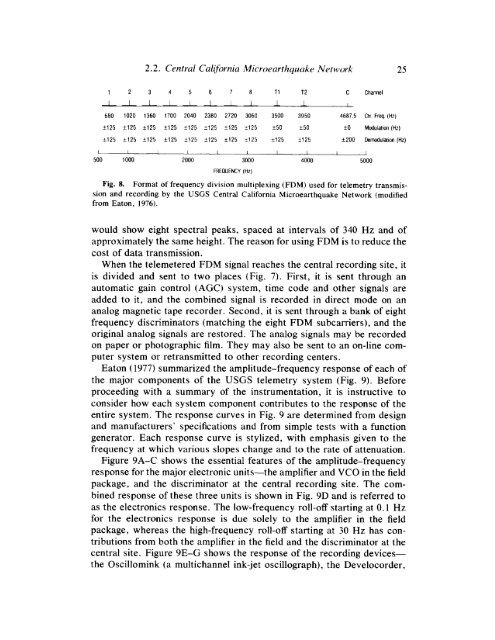principles and applications of microearthquake networks
principles and applications of microearthquake networks
principles and applications of microearthquake networks
Create successful ePaper yourself
Turn your PDF publications into a flip-book with our unique Google optimized e-Paper software.
2.2. Central California Microearthquake Network 25<br />
1 2 3 4 5 6 7 8 T1 T2 C Channel<br />
I I I I I I 1 I 1 1 I<br />
680 1020 1360 1700 2040 2380 2720 3060 3500 3950 46875 Ctr Freq (HI)<br />
+I25 k125 k125 f125 i125 i125 +125 2125 f50 k50 k0 Modulation (Hz)<br />
k125 i125 +125 f125 f125 f125 k125 2125 z125 f125 +ZOO Derodulation (Hz)<br />
I I 1 I I I I I I 1<br />
500 1000 2000 3000 4000 5000<br />
FREOUENCY (Hz)<br />
Fig. 8. Format <strong>of</strong> frequency division multiplexing (FDM) used for telemetry transmission<br />
<strong>and</strong> recording by the USGS Central California Microearthquake Network (modified<br />
from Eaton, 1976).<br />
would show eight spectral peaks, spaced at intervals <strong>of</strong> 340 Hz <strong>and</strong> <strong>of</strong><br />
approximately the same height. The reason for using FDM is to reduce the<br />
cost <strong>of</strong> data transmission.<br />
When the telemetered FDM signal reaches the central recording site, it<br />
is divided <strong>and</strong> sent to two places (Fig. 7). First, it is sent through an<br />
automatic gain control (AGC) system, time code <strong>and</strong> other signals are<br />
added to it, <strong>and</strong> the combined signal is recorded in direct mode on an<br />
analog magnetic tape recorder. Second, it is sent through a bank <strong>of</strong> eight<br />
frequency discriminators (matching the eight FDM subcarriers), <strong>and</strong> the<br />
original analog signals are restored. The analog signals may be recorded<br />
on paper or photographic film. They may also be sent to an on-line computer<br />
system or retransmitted to other recording centers.<br />
Eaton (1977) summarized the amplitude-frequency response <strong>of</strong> each <strong>of</strong><br />
the major components <strong>of</strong> the USGS telemetry system (Fig. 9). Before<br />
proceeding with a summary <strong>of</strong> the instrumentation, it is instructive to<br />
consider how each system component contributes to the response <strong>of</strong> the<br />
entire system. The response curves in Fig. 9 are determined from design<br />
<strong>and</strong> manufacturers’ specifications <strong>and</strong> from simple tests with a function<br />
generator. Each response curve is stylized, with emphasis given to the<br />
frequency at which various slopes change <strong>and</strong> to the rate <strong>of</strong> attenuation.<br />
Figure 9A-C shows the essential features <strong>of</strong> the amplitude-frequency<br />
response for the major electronic units-the amplifier <strong>and</strong> VCO in the field<br />
package, <strong>and</strong> the discriminator at the central recording site. The combined<br />
response <strong>of</strong> these three units is shown in Fig. 9D <strong>and</strong> is referred to<br />
as the electronics response. The low-frequency roll-<strong>of</strong>f starting at 0.1 Hz<br />
for the electronics response is due solely to the amplifier in the field<br />
package, whereas the high-frequency roll-<strong>of</strong>f starting at 30 Hz has contributions<br />
from both the amplifier in the field <strong>and</strong> the discriminator at the<br />
central site. Figure 9E-G shows the response <strong>of</strong> the recording devicesthe<br />
Oscillomink (a multichannel ink-jet oscillograph), the Develocorder,






